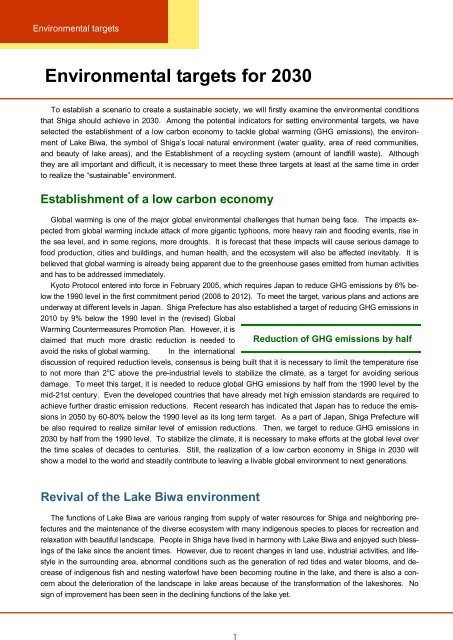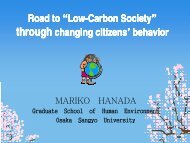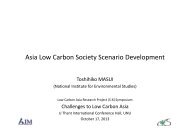Shiga’s scenario towards the realization of a sustainable society
Shiga's scenario towards the realization of a sustainable society
Shiga's scenario towards the realization of a sustainable society
- No tags were found...
You also want an ePaper? Increase the reach of your titles
YUMPU automatically turns print PDFs into web optimized ePapers that Google loves.
Environmental targets<br />
Environmental targets for 2030<br />
To establish a <strong>scenario</strong> to create a <strong>sustainable</strong> <strong>society</strong>, we will firstly examine <strong>the</strong> environmental conditions<br />
that Shiga should achieve in 2030. Among <strong>the</strong> potential indicators for setting environmental targets, we have<br />
selected <strong>the</strong> establishment <strong>of</strong> a low carbon economy to tackle global warming (GHG emissions), <strong>the</strong> environment<br />
<strong>of</strong> Lake Biwa, <strong>the</strong> symbol <strong>of</strong> <strong>Shiga’s</strong> local natural environment (water quality, area <strong>of</strong> reed communities,<br />
and beauty <strong>of</strong> lake areas), and <strong>the</strong> Establishment <strong>of</strong> a recycling system (amount <strong>of</strong> landfill waste). Although<br />
<strong>the</strong>y are all important and difficult, it is necessary to meet <strong>the</strong>se three targets at least at <strong>the</strong> same time in order<br />
to realize <strong>the</strong> “<strong>sustainable</strong>” environment.<br />
Establishment <strong>of</strong> a low carbon economy<br />
Global warming is one <strong>of</strong> <strong>the</strong> major global environmental challenges that human being face. The impacts expected<br />
from global warming include attack <strong>of</strong> more gigantic typhoons, more heavy rain and flooding events, rise in<br />
<strong>the</strong> sea level, and in some regions, more droughts. It is forecast that <strong>the</strong>se impacts will cause serious damage to<br />
food production, cities and buildings, and human health, and <strong>the</strong> ecosystem will also be affected inevitably. It is<br />
believed that global warming is already being apparent due to <strong>the</strong> greenhouse gases emitted from human activities<br />
and has to be addressed immediately.<br />
Kyoto Protocol entered into force in February 2005, which requires Japan to reduce GHG emissions by 6% below<br />
<strong>the</strong> 1990 level in <strong>the</strong> first commitment period (2008 to 2012). To meet <strong>the</strong> target, various plans and actions are<br />
underway at different levels in Japan. Shiga Prefecture has also established a target <strong>of</strong> reducing GHG emissions in<br />
2010 by 9% below <strong>the</strong> 1990 level in <strong>the</strong> (revised) Global<br />
Warming Countermeasures Promotion Plan. However, it is<br />
claimed that much more drastic reduction is needed to Reduction <strong>of</strong> GHG emissions by half<br />
avoid <strong>the</strong> risks <strong>of</strong> global warming. In <strong>the</strong> international<br />
discussion <strong>of</strong> required reduction levels, consensus is being built that it is necessary to limit <strong>the</strong> temperature rise<br />
to not more than 2 o C above <strong>the</strong> pre-industrial levels to stabilize <strong>the</strong> climate, as a target for avoiding serious<br />
damage. To meet this target, it is needed to reduce global GHG emissions by half from <strong>the</strong> 1990 level by <strong>the</strong><br />
mid-21st century. Even <strong>the</strong> developed countries that have already met high emission standards are required to<br />
achieve fur<strong>the</strong>r drastic emission reductions. Recent research has indicated that Japan has to reduce <strong>the</strong> emissions<br />
in 2050 by 60-80% below <strong>the</strong> 1990 level as its long term target. As a part <strong>of</strong> Japan, Shiga Prefecture will<br />
be also required to realize similar level <strong>of</strong> emission reductions. Then, we target to reduce GHG emissions in<br />
2030 by half from <strong>the</strong> 1990 level. To stabilize <strong>the</strong> climate, it is necessary to make efforts at <strong>the</strong> global level over<br />
<strong>the</strong> time scales <strong>of</strong> decades to centuries. Still, <strong>the</strong> <strong>realization</strong> <strong>of</strong> a low carbon economy in Shiga in 2030 will<br />
show a model to <strong>the</strong> world and steadily contribute to leaving a livable global environment to next generations.<br />
Revival <strong>of</strong> <strong>the</strong> Lake Biwa environment<br />
The functions <strong>of</strong> Lake Biwa are various ranging from supply <strong>of</strong> water resources for Shiga and neighboring prefectures<br />
and <strong>the</strong> maintenance <strong>of</strong> <strong>the</strong> diverse ecosystem with many indigenous species to places for recreation and<br />
relaxation with beautiful landscape. People in Shiga have lived in harmony with Lake Biwa and enjoyed such blessings<br />
<strong>of</strong> <strong>the</strong> lake since <strong>the</strong> ancient times. However, due to recent changes in land use, industrial activities, and lifestyle<br />
in <strong>the</strong> surrounding area, abnormal conditions such as <strong>the</strong> generation <strong>of</strong> red tides and water blooms, and decrease<br />
<strong>of</strong> indigenous fish and nesting waterfowl have been becoming routine in <strong>the</strong> lake, and <strong>the</strong>re is also a concern<br />
about <strong>the</strong> deterioration <strong>of</strong> <strong>the</strong> landscape in lake areas because <strong>of</strong> <strong>the</strong> transformation <strong>of</strong> <strong>the</strong> lakeshores. No<br />
sign <strong>of</strong> improvement has been seen in <strong>the</strong> declining functions <strong>of</strong> <strong>the</strong> lake yet.






